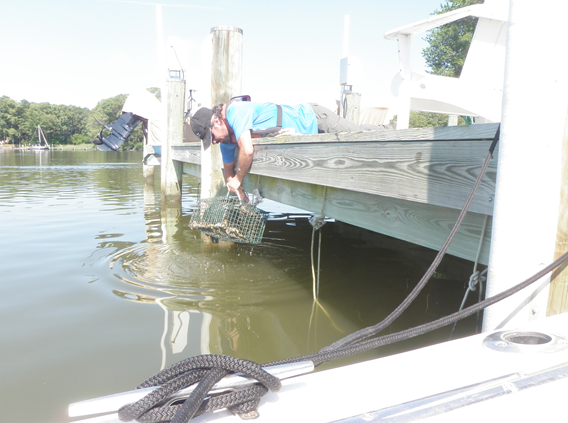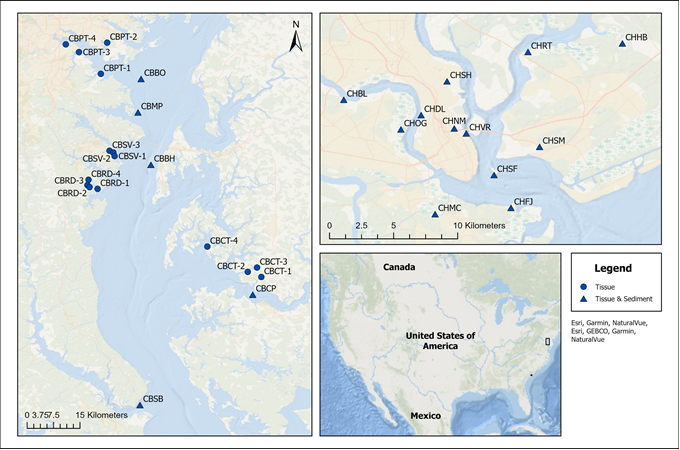
The Mussel Watch Program has monitored the nation’s coastal waters for chemical contaminants since 1986 and in recent decades has expanded its monitoring to include trace metals, legacy contaminants, and contaminants of emerging concern (CECs). In 2015, Mussel Watch collected sediment and oyster (Crassostrea virginica) samples from a network of 35 sites in the Chesapeake Bay and Charleston Harbor. Results from this study will support a better understanding of the sources, fate, and transport of contaminants in both regions and will fill important data gaps for local stakeholders.
Why We Care
Chesapeake Bay is the largest estuarine system in the continental United States, with a watershed that covers over 64,000 square miles over parts of six states and provides critical habitats for wildlife and important fisheries (NOAA, 2021). However, centuries of land development and agricultural and industrial activities have degraded water quality in the bay and its tributaries as a result of toxic chemical pollution, extensive sedimentation, and hypoxic (low oxygen) conditions (Hartwell and Hameedi, 2007; Newell, 1988; US EPA et al., 2012).
Thousands of chemical contaminants from many land-based point and nonpoint sources accumulate in Chesapeake Bay and Charleston Harbor every day, compromising water quality and, consequently, threatening human and ecosystem health. Previous studies in both regions have investigated legacy contaminants, such as trace elements and persistent organic pollutants (e.g., polychlorinated biphenyls (PCBs), organochlorine pesticides, chlordane, and polycyclic aromatic hydrocarbons (PAHs)). These research and monitoring efforts have helped managers limit the impact that legacy contaminants have on coastal ecosystems, but such efforts are lacking for the increasing number of new and unregulated compounds known as contaminants of emerging concern (CECs), many of which are known to be harmful to people, animals, and the environment.
In response to resource managers’ concerns about the extent and impact of these chemical stressors, the Mussel Watch Program conducted basin-wide surveys in 2015 to assess the magnitude and distribution of a suite of CECs, metals, and legacy contaminants in Chesapeake Bay and Charleston Harbor.
What We Are Doing
The Mussel Watch Program uses an ecosystem-based approach to monitoring, which entails measuring the concentration of chemical contaminants in sediments and the tissues of indigenous bivalves, such as oysters and mussels, as a way to evaluate local environmental quality. Bivalves are used as indicator organisms for chemical pollution because they tend to bioaccumulate contaminants from the large amounts of water they filter, they have limited mobility, and they are found throughout the U.S. coastal zone.
The program currently analyzes sediment and bivalves for both legacy contaminants and CECs. Legacy contaminants, monitored by Mussel Watch since 1986, include compounds such as chlordanes, chlorobenzenes, dichlorodiphenyltrichloroethane (DDT), dieldrins, endosulfans, hexachlorocyclohexanes (HCHs), butyltins, PAHs, and PCBs. The monitoring of CECs began in 2009 and includes contaminants such as alkylphenols, alternative flame retardants, current-use pesticides, (per- and polyfluoroalkyl substances (PFASs), polybrominated diphenyl ether (PBDEs), polybrominated biphenyls (PBBs), and pharmaceuticals and personal care products. In general, CECs are minimally regulated, not commonly monitored, but potentially toxic chemicals that are finding their way into the environment.
In 2015, Mussel Watch analyzed sediment and oyster (Crassostrea virginica) samples from 20 sites in Chesapeake Bay and 15 sites in Charleston Harbor for metals, legacy contaminants, and CECs. Chesapeake Bay and Charleston Harbor were selected for this CEC study because they represent estuarine environments with different land use types and because the study design offered opportunities to leverage resources and build stronger collaborations within NCCOS, as well as state and local resource managers in Maryland and South Carolina.
In Chesapeake Bay, the project benefited from the expertise of NCCOS’s Cooperative Oxford Laboratory, the Maryland Department of Natural Resources, and a network of citizen groups such as Marylanders Grow Oysters and River Keepers. In South Carolina, scientists from NCCOS’s Charleston and Hollings Marine Laboratories took the lead in conducting a field reconnaissance effort to identify appropriate survey sites.
Benefits of Our Work
This study supplies much-needed data to the national Mussel Watch Program and local stakeholders and managers in Chesapeake Bay and Charleston Harbor and informs water quality data used by coastal resource managers to develop effective, long-term policies to protect ecosystem services provided by the Chesapeake Bay and Charleston Harbor.

